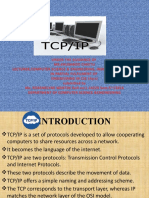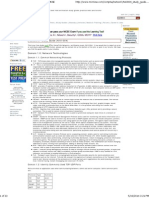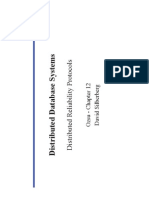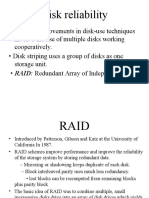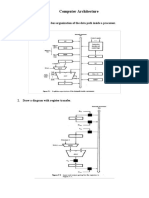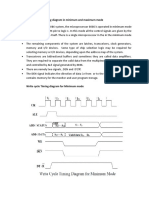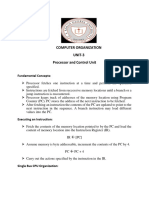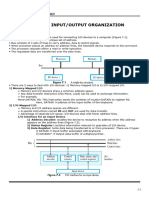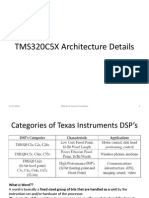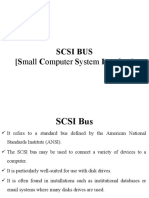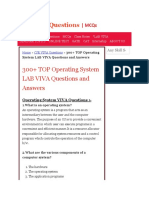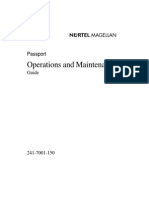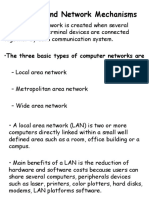Bus Arbitration
Uploaded by
Sabitha RajagopalBus Arbitration
Uploaded by
Sabitha RajagopalBus Arbitration
The device that is allowed to initiate data transfers on the bus at any given time is called
the bus master. In a computer system there may be more than one bus master such as
processor, DMA controller etc.
They share the system bus. When current master relinquishes control of the bus, another
bus master can acquire the control of the bus.
Bus arbitration is the process by which the next device to become the bus master is
selected and bus mastership is transferred to it. The selection of bus master is usually
done on the priority basis.
There are two approaches to bus arbitration: Centralized and distributed.
1. Centralized Arbitration
o In centralized bus arbitration, a single bus arbiter performs the required
arbitration. The bus arbiter may be the processor or a separate controller
connected to the bus.
o There are three different arbitration schemes that use the centralized bus
arbitration approach. There schemes are:
a. Daisy chaining
b. Polling method
c. Independent request
a) Daisy chaining
In this mechanism there are three bus lines which are Bus busy, Bus request and Bus grant
which are arranged in daisy chaining fashion. This is simple to achieve and only contains
three extra bus lines. This method has the poor fault tolerance and has the hardwired priority.
Steps to achieve daisy chaining mechanism:
a. Each devices checks, if bus is not busy then make bus request to the master.
b. Then master see the bus request like high, and then it activates the bus grant.
c. Then bus grant line travel from one device to another, in this time if a device gets a
bus grant, mark the bus busy.
It is simple and cheaper method. All masters make use of the same line for bus request.
In response to the bus request the controller sends a bus grant if the bus is free.
The bus grant signal serially propagates through each master until it encounters the first
one that is requesting access to the bus. This master blocks the propagation of the bus
grant signal, activities the busy line and gains control of the bus.
Therefore any other requesting module will not receive the grant signal and hence
cannot get the bus access.
b) Polling method
This is slightly a better mechanism. There is no such disadvantage of daisy
chaining. It has the possibility of dynamic priority. In this mechanism we have the log
n number of polling lines for n devices. Disadvantage of this mechanism is that, they
contain extra poll lines and they have a polling delay.
Steps to achieve polling mechanism
a. If bus is not busy, make bus request.
b. Master polls by placing device on polling lines. In this master decides priority.
c. If device gets access to the bus, mark bus busy.
In this the controller is used to generate the addresses for the master. Number of address
line required depends on the number of master connected in the system.
For example, if there are 8 masters connected in the system, at least three address lines
are required.
In response to the bus request controller generates a sequence of master address. When
the requesting master recognizes its address, it activated the busy line ad begins to use
the bus.
c) Independent request
This is the fastest mechanism in which also dynamic priority is possible. This is a mechanism
in which we have request and grant lines for each of the devices with master. This
mechanism has 2n lines for the n devices.
Steps to achieve independent request mechanism
a. If bus is not busy, make bus request.
b. Master decides who to grant access, and indicates through grant lines.
c. If device gets bus grant, make bus busy.
In this scheme each master has a separate pair of bus request and bus grant lines and
each pair has a priority assigned to it.
The built in priority decoder within the controller selects the highest priority request
and asserts the corresponding bus grant signal.
2. Distributed Arbitration
In distributed arbitration, all devices participate in the selection of the next bus master.
In this scheme each device on the bus is assigned a4-bit identification number.
The number of devices connected on the bus when one or more devices request for the
control of bus, they assert the start-arbitration signal and place their 4-bit ID numbers
on arbitration lines, ARB0 through ARB3.
These four arbitration lines are all open-collector. Therefore, more than one device can
place their 4-bit ID number to indicate that they need to control of bus. If one device
puts 1 on the bus line and another device puts 0 on the same bus line, the bus line status
will be 0. Device reads the status of all lines through inverters buffers so device reads
bus status 0as logic 1. Scheme the device having highest ID number has highest priority.
When two or more devices place their ID number on bus lines then it is necessary to
identify the highest ID number on bus lines then it is necessary to identify the highest
ID number from the status of bus line. Consider that two devices A and B, having ID
number 1 and 6, respectively are requesting the use of the bus.
Device A puts the bit pattern 0001, and device B puts the bit pattern 0110. With this
combination the status of bus-line will be 1000; however because of inverter buffers
code seen by both devices is 0111.
Each device compares the code formed on the arbitration line to its own ID, starting
from the most significant bit. If it finds the difference at any bit position, it disables its
drives at that bit position and for all lower-order bits.
It does so by placing a 0 at the input of their drive. In our example, device detects a
different on line ARB2 and hence it disables its drives on line ARB2, ARB1 and ARB0.
This causes the code on the arbitration lines to change to 0110. This means that device
B has won the race.
The decentralized arbitration offers high reliability because operation of the bus is not
dependent on any single device.
You might also like
- MCAN201 Data Structure With Python Questions For 1st InternalNo ratings yetMCAN201 Data Structure With Python Questions For 1st Internal2 pages
- Distibuted Database Management System NotesNo ratings yetDistibuted Database Management System Notes58 pages
- N+ Short Notes Free CompTIA Network+ Study Guide by MC MCSE)No ratings yetN+ Short Notes Free CompTIA Network+ Study Guide by MC MCSE)23 pages
- DCCN Important Questions From All Units Test-1 - 1No ratings yetDCCN Important Questions From All Units Test-1 - 14 pages
- Q. 28 Explain Asynchronous Data Transfer Using Timing Diagrams. AnsNo ratings yetQ. 28 Explain Asynchronous Data Transfer Using Timing Diagrams. Ans14 pages
- Program - : AIM: Write A C Program To Implement Goback N Sliding Window Protocol DescriptionNo ratings yetProgram - : AIM: Write A C Program To Implement Goback N Sliding Window Protocol Description5 pages
- Operating System Unit Wise Important Questions: S. No. Blooms Taxonomy Level Course Outcomes100% (1)Operating System Unit Wise Important Questions: S. No. Blooms Taxonomy Level Course Outcomes12 pages
- Computer Architecture: 1. Draw A Diagram Single Bus Organization of The Data Path Inside A ProcessorNo ratings yetComputer Architecture: 1. Draw A Diagram Single Bus Organization of The Data Path Inside A Processor8 pages
- Interrupt Structure and Processing of 8086No ratings yetInterrupt Structure and Processing of 808616 pages
- MODULE 3: 8051 Programming in C: Microcontroller Notes:18EE52100% (1)MODULE 3: 8051 Programming in C: Microcontroller Notes:18EE5262 pages
- Computer Organization and Architecture (18EC35) - Input/Output Organization (Module 3)50% (2)Computer Organization and Architecture (18EC35) - Input/Output Organization (Module 3)82 pages
- DDCO SEM III Mod 4 Notes For Sem Exam @vtunetworkNo ratings yetDDCO SEM III Mod 4 Notes For Sem Exam @vtunetwork29 pages
- CHAPTER 04: Peripherals Interfacing With 8086 and Applications100% (1)CHAPTER 04: Peripherals Interfacing With 8086 and Applications17 pages
- Unit IV Disk Scheduling Algorithms: Disk Access Time Seek Time + Rotational Latency + Transfer TimeNo ratings yetUnit IV Disk Scheduling Algorithms: Disk Access Time Seek Time + Rotational Latency + Transfer Time10 pages
- Progrma No.1-: C Program For First Come First Served (FCFS) CPU Scheduling AlgorithmNo ratings yetProgrma No.1-: C Program For First Come First Served (FCFS) CPU Scheduling Algorithm15 pages
- (SS) System Software Viva Question and AnswersNo ratings yet(SS) System Software Viva Question and Answers15 pages
- Computer Organization UNIT-3 Processor and Control Unit: Fundamental ConceptsNo ratings yetComputer Organization UNIT-3 Processor and Control Unit: Fundamental Concepts23 pages
- Software and Hardware Interrupt Applications100% (1)Software and Hardware Interrupt Applications10 pages
- UNIT-3 I/O and Memory Interfacing With 8051100% (1)UNIT-3 I/O and Memory Interfacing With 805142 pages
- CS2354 Advanced Computer Architecture Anna University Question Paper For MENo ratings yetCS2354 Advanced Computer Architecture Anna University Question Paper For ME2 pages
- Unit - Iv: Advanced Microprocessors: Salient Features of 80386No ratings yetUnit - Iv: Advanced Microprocessors: Salient Features of 8038614 pages
- Experiment: 5 (A) : A) Write A Program For The 8051 To Transfer Letter "A" Serially, ContinuouslyNo ratings yetExperiment: 5 (A) : A) Write A Program For The 8051 To Transfer Letter "A" Serially, Continuously2 pages
- 159 - CS8493, CS6401 Operating Systems - Question Bank100% (1)159 - CS8493, CS6401 Operating Systems - Question Bank8 pages
- Comparative Study of 80286,80386,80486, Pentium Processors100% (2)Comparative Study of 80286,80386,80486, Pentium Processors4 pages
- Serial Communication Bus-Interface (Unit3)100% (2)Serial Communication Bus-Interface (Unit3)44 pages
- Unit-1 (Cloud Computing) 1. (Accessible) Scalable Computing Over The Internet100% (1)Unit-1 (Cloud Computing) 1. (Accessible) Scalable Computing Over The Internet17 pages
- DMA Controller 8237:: Comparison of 8257 and 8237No ratings yetDMA Controller 8237:: Comparison of 8257 and 823715 pages
- 300+ TOP Operating System LAB VIVA Questions and AnswersNo ratings yet300+ TOP Operating System LAB VIVA Questions and Answers33 pages
- L2& L3-Computer Organization and ArchitectureNo ratings yetL2& L3-Computer Organization and Architecture13 pages
- Aixtechblog Wordpress Com 2016 09 19 How To Remove Powerha System Mirror Hacmp ConfigurationNo ratings yetAixtechblog Wordpress Com 2016 09 19 How To Remove Powerha System Mirror Hacmp Configuration1 page
- 10.1.4.8 Lab - Configure ASA 5506-X Basic Settings and Firewall Using ASDM - InstructorNo ratings yet10.1.4.8 Lab - Configure ASA 5506-X Basic Settings and Firewall Using ASDM - Instructor26 pages
- Introduction To Computer Network: by Ajay Singh Meena Class: Xii-E Roll No.: 04100% (1)Introduction To Computer Network: by Ajay Singh Meena Class: Xii-E Roll No.: 0430 pages
- Cisco DNAC 1.2.6 MUltiSIte-Lab Guide-Jul2019No ratings yetCisco DNAC 1.2.6 MUltiSIte-Lab Guide-Jul2019170 pages
- Agughasi Victor Ikechukwu - Final JournalNo ratings yetAgughasi Victor Ikechukwu - Final Journal14 pages
- Computer IT Cyber Law Model Questions JCINo ratings yetComputer IT Cyber Law Model Questions JCI59 pages
- Instant Access to Ad hoc Mobile and Wireless Networks 17th International Conference on Ad Hoc Networks and Wireless ADHOC NOW 2018 Saint Malo France September 5 7 2018 Proceedings Nicolas Montavont ebook Full Chapters100% (4)Instant Access to Ad hoc Mobile and Wireless Networks 17th International Conference on Ad Hoc Networks and Wireless ADHOC NOW 2018 Saint Malo France September 5 7 2018 Proceedings Nicolas Montavont ebook Full Chapters62 pages
- Computer Networking Notes For Tech Placements (Important)No ratings yetComputer Networking Notes For Tech Placements (Important)16 pages
- SBS 2003-Securing Your Windows Small Business Server 2003 NetworkNo ratings yetSBS 2003-Securing Your Windows Small Business Server 2003 Network28 pages
- Communication Systems: Introduction To Data CommunicationsNo ratings yetCommunication Systems: Introduction To Data Communications40 pages
- Challenges in Iot Networking Via Tcp/Ip ArchitectureNo ratings yetChallenges in Iot Networking Via Tcp/Ip Architecture7 pages

